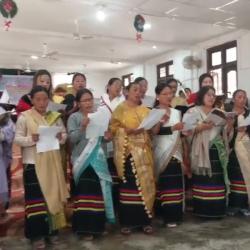The veterinary service delivery is of paramount importance in the context of not only animal health and welfare but also trade, food security, food safety, climate change and above all the human health. Research indicates that 75 percent of infectious agents known to be emerging in human population are deemed zoonotic.Because of its long international border, large population of wild animals etc., Assam and the North eastern region in general, is also prone to emergencies and socio-economic disruptions resulting from Highly Pathogenic Emerging and re-emerging diseases (HPED). Thescientific community worldwide has recognized the need for inter-sectoral, integrated interventions essentially targeting human – animal –ecosystem interface issues (One Health approach) to control diseases in high risk areas and emergencies thereof. A vibrant and well equipped veterinary department is a must to make this happen. The discussion above clearly indicates the need of leadership and priority for public investments in veterinary and animal husbandry.
The Department of Animal Husbandry and Veterinary in Assam which is the lead regulatory organization and also one of the prime custodian of assets and public investment into the sector, is passing through a long standing leadership crisis at almost all level. As per a recent news report, the department is functioning with unprecedented number of vacancies. The crisis has affected not only the execution of ongoing development projects but also the regulatory and disease control related public functions. Though there is no dearth of technical man-power, the department is increasingly facing the challenge of limited in-houseleadership to plan, design and implement sustainable programs and projects. At a time when government of India is emphasizing on decentralized planning and program development and funds are being allocated accordingly, this inadequacy assumes significant importance. The situation is alarming and needs urgent attention of politicians, policy think tanks, farmers of the state and public in general.
If we look into the recent history, a very important event that has created a leadership void is the long drawn-out financial scandal in the State known as the “LOC scandal (Scandal related to submission of false Letters of Credit)”. Elaborating on the impact of the scandal, Dr.Hiren Gohain (1996) wrote: “starting from a remote cattle development center of the Veterinary Department, the scam spread to 11 departments of the State government. The Central Bureau of Investigation (CBI) of GOI was allowed to probe only the Animal Husbandry and Veterinary Department. Naturally, the Veterinary Department has been labelled as the department of the “LOC scandal”. Although the scandal involved politicians, contractors, as well as suppliers, people in Assam would commonly associate the veterinarians with corruption. It has been alleged that because subsequent governments had the impression that the Veterinary Department is prone to corruption, it was reluctant to provide the required funding for its developmental activities”. Even today, the scandal is viewed as one of the biggest causes of low morale of veterinarians working in the State. Still there seems to be a lack of trust on Veterinarian by the senior government officials’ and civil servants in-charge of administration andimplementation of integrated programs. Many however, blame this on the lack of assertiveness on the part of veterinarians working at field level.
The leadership crisis has precipitated in last ten to fifteen years as practically no investments went into building internal capacity of the department. It is to be noted that the recent investments in building of stationary hospitals, laboratories and staff quarters though addressed the core infrastructure challenge to some extent; infrastructure to reach out to farmers at their door step is still grossly inadequate.The veterinary department in Odisha hasmade provision for mobile veterinary unit covering all the 314 administrative blocks within the state.Government of West Bengal too has initiated steps to create support structures in every village. Many states in India have vastly improved their private sector engagement and communication related to programs and projects. In Assam, though there are instances of excellent program implementation in some areas, they are hardly communicated for larger partnership and as such support for scaling up of the interventions are not forthcoming.
Another important aspect linked to leadership is the fact that statutory organizations like State Veterinary Councilto govern the services of veterinarians have not been aptly empowered. Large numbers of working field veterinarian in rural areas are hardly getting any opportunity to participate in continuous education programs.
The leadership crisis within the department can be addressed with proper management intervention and stakeholders’ engagement at all level. The need is to bring in an environment of mutual trust and attitudinal transformation amongst the working officers. The department must tap the pool of knowledge outside its own supported institutions and collaborate based on resources in local context.The urge for preparing the department to go through a change process of collaboration must come from within and no amount of outside leadership can help to revive the situation.
The service association of the department has been aptly raising the issue of long standing vacancies within the department. The filling up of the vacancies through deserving promotions islinked to ongoing project implementation and improvement ofmuch needed moral of serving officers. However, filling up of the vacancies alone will not guaranty improvement in leadership and program implementations thereof. It’s time for the department to explore policy options of outsourcing private veterinarians for select public functions. The department at this juncture needs a thorough organizational development exercise focusing on strategic human resource management, strong communication and partnership strategy.
- 9598 reads










Add new comment